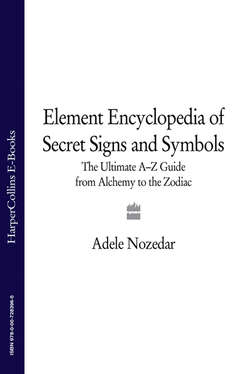Читать книгу The Element Encyclopedia of Secret Signs and Symbols: The Ultimate A–Z Guide from Alchemy to the Zodiac - Adele Nozedar - Страница 282
JAIN SYMBOL
ОглавлениеAlso called the Parasparopgraho Jivanam, this sacred symbol of the ancient Jain faith (an offshoot of Hinduism) is constructed from several other signs and symbols.
First, the outline of the symbol is called the Lok and is representative of the Universe. The lower part reminds Jains of the concept of Seven Hells. The central part represents the Earthly plane, and the upper portion represents the Heavens. Then, working from the top down, the curved arc represents not only the Moon, but is called the Siddhasila, the final resting-place of souls that have been liberated from the karmic wheel of death and rebirth. These souls are called Siddhas.
The dot or bindhu within the arc is indicative of the zero, the every thing and the nothing combined. It is also representative of the Siddha.
Below the arc are three further bindhu. These represent the Three Jewels of Jainism, namely, the rules for attaining the desired liberation of the soul. These rules are:
Right Faith (Samyak Darshan)
Right Knowledge (Samyak Jnan)
Right Conduct (Samyak Charitra)
Below these three sacred dots is the swastika, the very ancient solar symbol. Here, the four arms of the swastika symbolize the four realms into which a soul may be reborn; a soul can become a heavenly being, a human being, an animal being, or a hellish being.
Underneath the swastika is the upraised hand, a universal symbol meaning “Stop!” Inside the hand is the word “Ahimsa,” one of the tenets of Hinduism and Jainism, which is an offshoot of this faith. Ahimsa means “nonviolence” and the word itself is contained within a wheel. The combination of the hand and the word within the wheel are a reminder to stop and think before acting, to do nothing which could harm any creature, otherwise the wheel of birth and rebirth will keep on turning and the soul will never be liberated.
